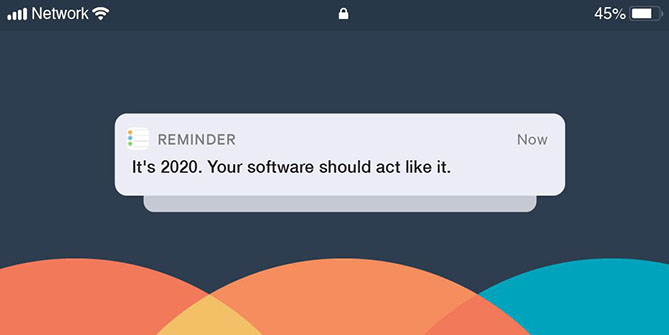“Old and clunky”
“So hard to use”
“This makes my head hurt”
“The product feels like it was built without any customers in mind”
Perhaps enterprise software providers should consider one of these phrases for the tagline of their next campaign. After all, they are direct quotes from users of their tools, left on review site G2.
The general consensus? Their software sucks. Really sucks.
How is this still the case in 2020? We live in an age of artificial intelligence, autonomous vehicles, and augmented reality. We are awash with incredibly advanced technology. But marketers still can’t find an enterprise software solution that doesn’t make their head hurt.
As far back as 2009, there were calls on enterprise software providers to pay more attention to the user-friendliness of their products, but like the proverbial ostrich, they put their head in the sand, rested on their laurels, and blindly trusted the lazy assumption that customers will forever accept pain as the price of power.
It’s one of the most extreme examples I’ve seen of Jim Collins’ ‘tyranny of the OR ’ concept — the destructive tendency of some businesses to view all decisions as binary; a choice between A or B, but never both. Enterprise software providers have for years had the option to offer marketers tools that are both powerful and easy to use. But they haven’t. Rather, they’ve consistently fallen victim to the ‘tyranny of the OR’, pushing out endless features that are only powerful and never, ever easy to use.
Frankly, there’s no excuse for this. In recent years we’ve seen companies like Zoom, Shopify, and Slack refuse to compromise like other enterprise software providers. They’ve listened to customers, they’ve embraced advanced technologies, and they’ve completely transformed their industries by offering consumer-grade usability along with the deep power needed by rapidly growing businesses.
Y Combinator co-founder, Paul Graham, recently called out the vulnerability of enterprise software providers still stuck in the past, suggesting that they could someday “suddenly crumble.”

That day is coming sooner than you might think.
One third of B2B buyers say their customer experience expectations have increased. Even more say they’re ready to switch to a better solution. It’s time marketers were given an enterprise software solution they’ll actually enjoy using. One that combines power and ease-of-use. One that doesn’t suck.
The Burden of the Legacy System
So how did enterprise software providers lose their way? In short, they failed to adapt to the breadth of needs of the modern marketing team, which has undergone a major transformation over the past decade.
The explosion of marketing technology accelerated this transformation and significantly expanded the archetypes of marketers. New tools gave rise to new specialties and skill sets, which, when combined well, can make modern marketing teams greater than the sum of their parts. Enterprise software’s race to keep up was choppy at best, and it sacrificed usability as it added new features. Heading into the new decade, growing businesses have no choice but to demand more from their enterprise software. Customer expectations have risen to new heights, thanks to a wave of new B2C innovators that have disrupted entire industries by prioritizing user experience above all else.
Casper will ship a mattress to your door as if it was delivery pizza, Robinhood will let you trade stocks while you wait for the bus, and Netflix will give you — yes, you, personally — a carefully curated list of movie recommendations every time you sign in.
So why is it still so infuriatingly difficult to build a simple email campaign with most enterprise marketing tools?
Today’s providers, despite their big promises and wordy taglines, slow businesses down precisely at the moment they need to be moving faster. Over time, their software becomes overloaded with unnecessary forms, fields, workflows, and more, all of which get in the way of marketers trying to deliver the type of experience their customers expect.
For marketing operations leaders, this pain is multiplied. Whenever any marketer on their team is let down by their software — be they an email marketer struggling to segment a list, or a marketing analyst trying in vain to generate a report — the ops leader feels their pain. They are deep in the weeds with every tool, forced to wrestle daily with unwieldy systems that aren’t fit for purpose. And when those systems inevitably fail, they’re the ones on the front lines, trying to find a fix.
So why do so many marketers and operations leaders still put up with all of this complexity and clunkiness? Why don’t they simply switch to a different platform more suited to their needs?
Enterprise software providers have convinced their users that complex tools are in fact essential if they want to do complex things. They present confusion and clunkiness as an indicator of power, and ease-of-use as an indicator of technological limitations. It’s a myth. And it’s perpetuated by incumbents to dupe their customers into sticking with the same outdated, counter-intuitive platforms year after year.
For too long, enterprise software providers have gotten away with foisting tools built for the past on businesses trying to create the future.
Move Fast and Market Things
What growing businesses deserve is enterprise software that’s built for the modern era — solutions that combine power and ease-of-use, and make it easy for them to put their most innovative ideas into practice, fast.
Speed has always mattered in marketing. The early adopters of email marketing saw open rates that marketers today can only dream of. The first Facebook advertisers got phenomenal bang for their buck. The quickest SEO strategists enjoyed years of first-page SERP rankings. To take advantage of marketing’s new frontiers and stay ahead of the competition, marketers need to be able to innovate quickly and execute efficiently.
And yet, slow strategy execution and insufficient digital capabilities remain top concerns of business leaders heading into the new decade. These two concerns are opposite sides of the same coin — without the right tools, strategy execution will never be fast enough. The enterprise platform you buy in 2020 should be able to evolve and adopt new technical approaches in such a way so that it is almost an entirely different platform by the time you hit 2022. It should combine innovation within its own feature set with extensibility found through integrations and an active app ecosystem. Slow-to-evolve technology leads to outdated marketing strategies. Maintaining seamless usability while steadily evolving will be the superpower of the next era of enterprise software.
Putting Enterprise Software to the Test
With the wealth of powerful technology now available, growing businesses have an opportunity as never before to truly delight their customers, and gain a competitive advantage by doing so. But when it comes to choosing an enterprise software solution to fuel this growth, information asymmetry can get in the way of buyers picking the right provider for their team’s needs. The software evaluation process is notoriously noisy, as salespeople bamboozle buyers with bells, whistles, and add-ons they don’t need and will never use.
To cut through the noise and simplify the buying process, marketing and operations leaders should focus on five key ‘tests’. If the software doesn’t pass all five with flying colors, it isn’t right for any business that wants to grow better.
1. The Speed Test — enterprise software should significantly reduce the amount of time it takes marketers to complete essential tasks like building an email campaign and running a report. The less time it takes to complete standard tasks, the more time there is to focus on delighting customers.
2. The People Test — it’s a given that every type of marketer, from data analyst to creative designer, should be able to work with their company’s enterprise software, but they should also each have an equally positive experience with it. If even one marketing function isn’t set up for success with its software, it will negatively impact all aspects of the team’s work.
3. The Customer Test — enterprise software should make marketers’ jobs easier, and should therefore be loved by its users. If its reviews on sites like G2.com and Capterra aren’t glowing, it’s a sign that there could be usability or functionality issues, which may only show up after a contract is signed.
4. The Window Test — if completing standard marketing tasks requires multiple windows and tabs open at the same time, it’s an indicator that the software is not built with user-friendliness in mind. The more tabs open, the greater the likelihood of oversights, errors, and ultimately, unhappy customers.
5. The Extensibility Test — enterprise software should grow with a business. Full stop. As a team’s needs evolve, it should be easy to integrate new tools directly into its flow of work, and to sync data bidirectionally. Systems that lack this ability can stifle innovation and create stagnation. Customers’ expectations are always evolving and marketers need to be able to adopt new tools that help them offer ongoing delightful experiences.
It’s 2020. Businesses should not have to compromise on any of these essential requirements of a modern enterprise marketing solution. Emailing should be enjoyable. Reporting should be reliable. Segmentation should be straightforward. A/B testing should not test your patience. This is what enterprise software should look like. And with the newly revamped Marketing Hub Enterprise, it does.
At the beginning of this post, I shared quotes from G2 reviews of enterprise marketing software. And I will leave you with the words of another exasperated enterprise software user whose advice to marketers is to simply, “Save your time and use HubSpot.”
HubSpot’s Marketing Hub Enterprise now includes new revenue attribution reporting, partitioning, AI-powered A/B testing, and ABM features, as well as increased limits on lists and workflows.
Marketing Hub Enterprise: Always Easy. Now deeply powerful.
Marketing Strategy






![The state of inclusive marketing in 2025 [new data + expert insight]](https://53.fs1.hubspotusercontent-na1.net/hubfs/53/inclusive-marketing-report.webp)
![How marketers are navigating a possible recession (and advice about what you should do during it) [new data]](https://53.fs1.hubspotusercontent-na1.net/hubfs/53/image12-May-27-2025-02-18-19-8390-AM.png)



![Cultural Marketing: What It Is & How to Do It The Right Way [According to Experts]](https://53.fs1.hubspotusercontent-na1.net/hubfs/53/Untitled%20design%20-%202025-04-03T163531.949.jpg)